DRAVIDIAN TEMPLE ARCHITECTURE
Kanchipuram Temples
Pallava Period (7th - 9th century)
with later additions
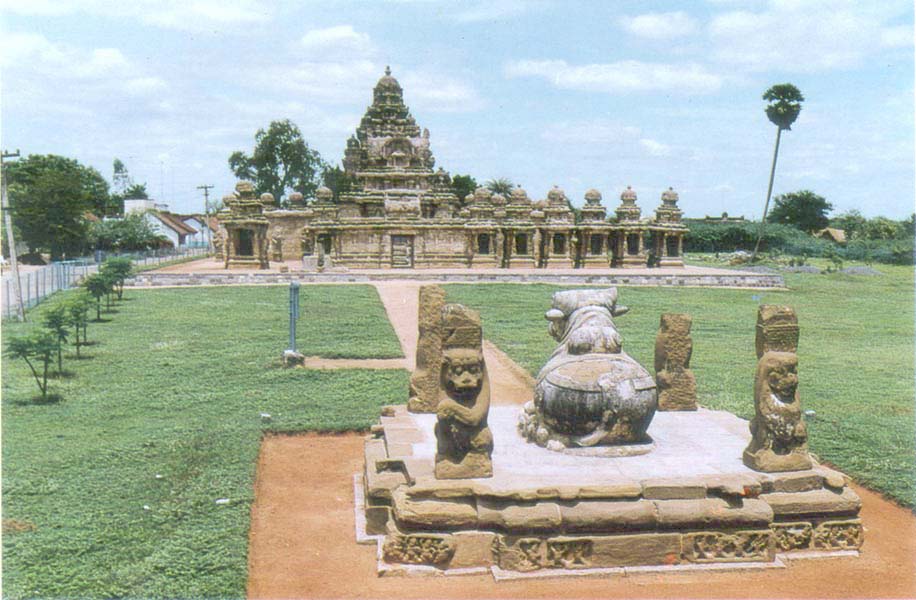
Kailasanatha Temple at
Kanchipuram
Professor T.V.Mahalingam,
University of Madras on Mahabalipuram in
Tamil
Art & Architecture paper presented at
Second International Conference Seminar of Tamil Studies,
January 1968
"...The Kailasanatha is four-storeyed and is
an example of sandharaprasada containing two walls providing
an ambulatory. The storeys are decorated with architectural
designs like kutas, kostas and panjaras. The pillars in
structural temples are with rampant lions generally and with
elephants, nagas and bhulas at times. Niches are to be seen
in both the rock-cut and structural temples and have a
makaratorana decoration on their top, the makaras in them
having floriated tails overflowing on the sides. The corbels
are generally curved in profile with the taranga (wave
moulding) ornament and a median band. The gopuras are absent
in these early temples. In the Kailasanatha at Kanchi and
the
Shore Temple
at Mahabalipuram there are faint but unmistakable
suggestions of gopuradhvaras which were to evolve into
towers. Another feature of these early structural temples is
the almost prodigal sculptural embellishment of the exterior
walls. The carvings are invariably those of deities, a few
of which appear to be fresh inceptions from the Calukyan
area..."
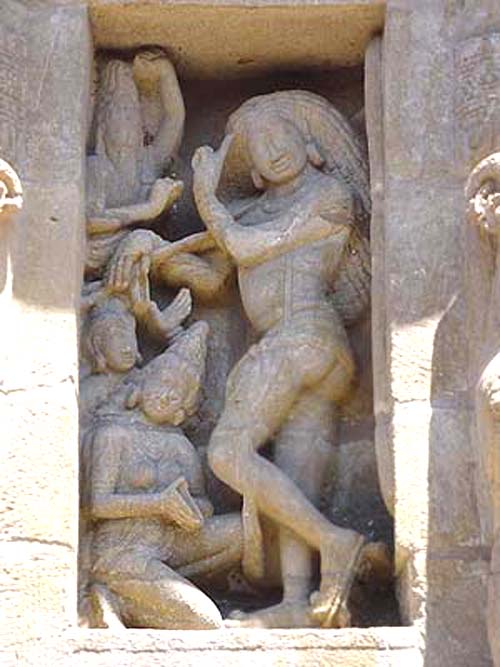
Siva the Mendicant
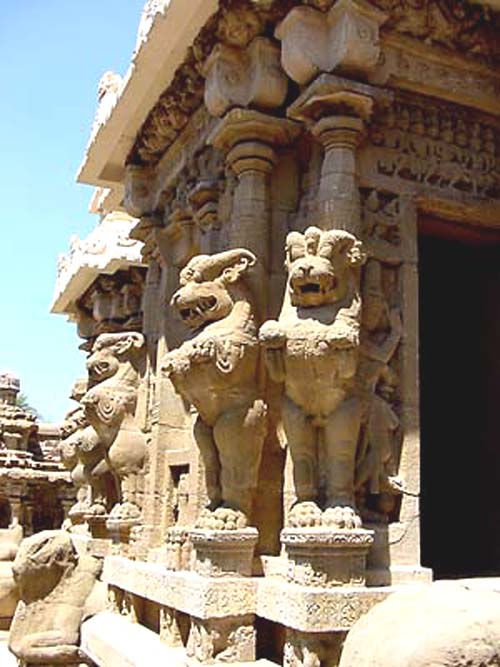
Rearing Yalis
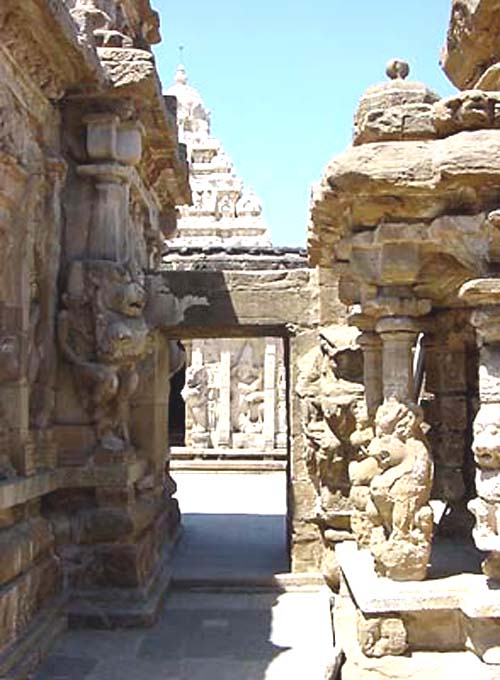
Courtesy:
Manas on Kanchipuram
"...Kanchipuram is among the most famous of
the 'temple cities' of Tamil Nadu. Its temples house
different Hindu sects. Though today it is only a destination
for pilgrims, and a repository of major architectural
monuments, in antiquity it occupied a more pre eminent place
in the history of South India. The city was the political
capital of the Pallava rulers during the 7th - 9th
centuries. It remained an important city during the
succeeding Chola and Vijayanagara periods.
The Kailasanatha temple is the finest
structural project of the Pallava ruler Rajasimha. The
temple is almost entirely constructed of sandstone and is
integrated into a coherent complex. A large variety of
Shaiva images adorns the outer walls; the inner walls were
once painted. A polished linga (phallus, the symbol of
regeneration associated with Shiva) is enshrined within..."
The
Ekambareshvara temple is the principle Shaiva sanctuary
and its soaring gopuras dominate the city's skyline. This
temple was erected in 1509 by the Vijayanagara emperor
Krishnadeva Raya. The temple is preceded by a long columned
mandapa into which earlier shrines and altars have been
incorporated. A corridor surrounds the principle shrine on
four sides, presenting a continuous sequence of receding
piers.
The Vardhamana temple is the most important
Vaishanava temple. Local legend has it that the temple
commemorates the site where the Lord Brahma performed a
yajna (fire sacrifice) to invoke the presence of Vishnu. It
has a long history spanning the Chola and the Vijayanagara
periods. One of the two high towered gopuras resemble
12th-13th century Chola projects while the other is
characteristic of the 16th century Vijayanagara period. The
main sanctuary enshrines bronze images of Vishnu flanked by
his consorts. Some specimens of Vijayanagara paintings are
still preserved on the walls..."
 Ekambaranathar
Temple, Kanchipuram
Ekambaranathar
Temple, Kanchipuram
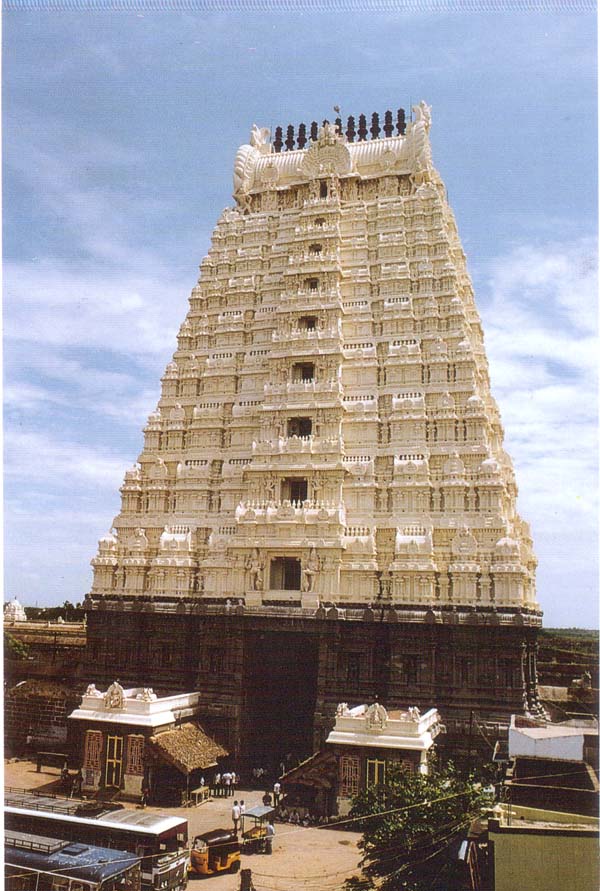
Ekambareswara
Temple - Tallest Gopuram (192 feet) Built in 1509 A.D
"...Ekambaranathar
Temple is one of the oldest temples in the city. The
architecture of this temple is amazing. The gopuram of this
temple stands as a massive landmark, spanning a height of 57
metres - one of the tallest in South India. The vast temple
premises introduce you to many wonders, one after
another. The first is the "Aayiram Kaal Mandapam" or the
hallway with a thousand pillars. The next is the array of
1008 Siva Lingams that decorate the inner walls of the
temple. The most important, of course, is the
"sthala-virutcham", a 3500 year old mango tree whose
branches give four different types of mangoes. This temple
bears the work of practically every dynasty which ruled
Kanchipuram...."
Courtesy:
Kanchipuram on the Web